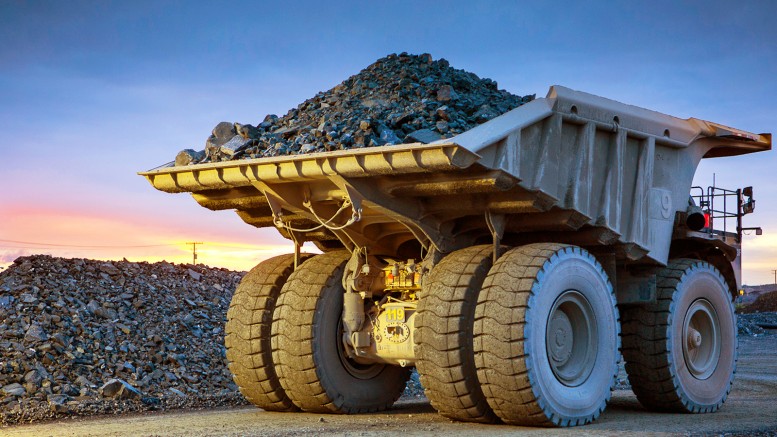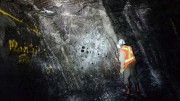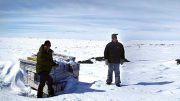VANCOUVER — Canada’s gold miners are naturally interested in discovery back home, but the push for more “homegrown” ounces appears to be on the rise after the recent downcycle, with oft-cited reasons including geopolitical risk, operational synergies and favourable infrastructure.
The Northern Miner reviewed exploration reports from three marquee Canadian producers to see where major miners are most active in Canada.
Barrick Gold
The world’s largest gold producer had its start near Wawa, Ont., but it subsequently consolidated major production centres in Nevada and beyond. Barrick Gold (TSX: ABX; NYSE: ABX) operates the historic Hemlo gold mine 35 km east of Marathon, Ont., however, where it drilled nearly 20,000 metres last year.
The asset consists of the Williams mine and processing facility located at the western end of the property, the Golden Giant mine in the central area and the David Bell mine in the east.
The investment expanded Hemlo’s reserves to 25.8 million tonnes grading 1.92 grams gold per tonne for nearly 1.6 million contained ounces. Barrick said the mine’s life could be extended through 2026 based on technical reports expected by year-end. The company also established the first geological model for the entire Hemlo deposit in 2016.
Meanwhile, Barrick signed two Canadian earn-in agreements during the first quarter. On March 27, the company announced a deal with Osisko Mining (TSX: OSK; US-OTC: OSKFF) wherein it can earn 70% in Osisko’s Kan gold property in northern Quebec’s Labrador Trough, for $15 million in exploration expenses over the next three years.

Barrick Gold‘s Hemlo gold mill, located 350 km east of Thunder Bay, Ontario. Credit: Barrick Gold.
Barrick must spend $6 million by the end of 2018, and earn another 5% interest by electing to fund $5 million more in project-level expenses (i.e., a preliminary economic assessment or prefeasibility study).
Barrick also closed an agreement with explorer Atac Resources (TSXV: ATC; US-OTC: ATADF) to earn 60% in the Orion gold project in the Yukon. The terms outline potential investment totalling $63.3 million, which includes a private placement of $8.3 million and a two-staged, $55-million exploration earn-in option to acquire up to 70% of Orion, which comprises the central portion of the 1,742 sq. km Rackla property, 100 km northeast of Keno City.

Core boxes at Atac Resources’ Rackla gold project in the Yukon. Credit: Atac Resources.
Barrick will also buy $6.3 million in Atac shares via a charity flow-through private placement, which will increase its equity stake from 9.2% to 19.9%.
“Exploration has been one of Barrick’s primary value drivers for a long time. After several years focused on existing core districts, this year, we’re increasing our investment in exploration, both near-mine and greenfield,” Barrick president Kelvin Dushnisky said during a first-quarter conference call.
Goldcorp
Vancouver-based Goldcorp (TSX: G; NYSE: GG) has strong presence in Canada with operations in Ontario and Quebec that could crank out 615,000 oz. gold in 2017. The company is also advancing a pipeline of Canadian exploration and development projects, which it expanded to the Yukon with its $520-million purchase of Kaminak Gold and the Coffee property last year.
In April, Goldcorp released an update on its 2017 exploration plans. The company reported in excess of 100,000 metres of diamond and reverse-circulation drilling that it expects to complete across its Canadian portfolio.

An aerial view of Goldcorp’s Red Lake gold operations. Credit: Goldcorp.
Goldcorp completed 31,300 metres of underground drilling at Red Lake during the first quarter, which focused on five main areas: the R zone/Lower 56, Upper Red Lake, Party Wall, Campbell and Lower Red Lake. Goldcorp’s proven and probable reserves in the Red Lake area total 7.6 million tonnes at 8.36 grams gold per tonne for 2 million contained oz. gold.
Meanwhile, Goldcorp is active in the Porcupine mining district in Ontario, where the company will drill 57,000 metres at surface and underground for its advanced-stage Century project. Porcupine consists of four mining operations: Hoyle Pond, Dome underground and the Hollinger open pit, which all feed the central Dome processing facility. The Porcupine assets jointly host 46 million proven and probable tonnes grading 1.55 grams gold tonne for 2.3 million contained oz. gold.
Goldcorp is active at two more recent acquisitions, namely Coffee, and the Borden project that it picked up via the $530-million Probe Mines acquisition in early 2015. Borden lies 160 km west of the Porcupine mine. The company is planning a regional exploration program to follow up on last year’s glacial till sampling.
Drilling at Borden West is targeting the Footwall Amphibolite contact and “associated gold zone along strike” from the Borden deposit. Mineralization could be associated with a garnet biotite felsic gneiss unit, with various amounts of quartz veining, flooding and sulphides.
Goldcorp started its annual field season at Coffee in March. The company mobilized twin reverse-circulation rigs and drilled 7,300 metres at the Supremo, T8-9 and Arabica targets. It is also planning a regional exploration program across the 600 sq. km property package later this year.
“We continue to invest in our pipeline and advance a number of projects forward, with a capital commitment of over $1 billion,” Goldcorp president and CEO David Garofalo said in March. “It has been a busy year as we transition to the harvest mode. We’ve got a quality profile right across the group, and each side is competitive for the dollars. The money will go to where we are getting the best results.”
Agnico Eagle Mines
Agnico Eagle Mines (TSX: AEM; NYSE: AEM) is the largest gold producer in Quebec, with a 100% interest in three mines — LaRonde, Goldex and Lapa — and a 50% interest in the Canadian Malartic joint venture with Yamana Gold (TSX: YRI; NYSE: AUY). Agnico also operates the Meadowbank mine in Nunavut, which is an emerging gold district following Agnico’s discovery of the Amaruq gold deposit.
Agnico aims to boost its total gold production to 2 million oz. per year by 2020.
In Quebec, exploration is largely focused on the Canadian Malartic complex. The partners completed nearly 23,000 metres of drilling at the Odyssey project during the first quarter, which could provide feed for the Canadian Malartic mill.

Agnico Eagle Mines’ Goldex gold mine in Quebec’s Abitibi region. Credit: Agnico Eagle Mines.
Agnico’s biggest Canadian exploration success of the past two years has been the rapid path from discovery to resource delineation at Amaruq, 50 km northwest of its Meadowbank mine. The company initiated a $22-million, 75,000-metre drill program at Amaruq in February. In the first quarter Agnico completed 119 holes over 17,900 metres, which focused on the the IVR zone and Whale Tail deposit, and a “possible expansion of the Whale Tail open-pit limit towards the west.”
Amaruq has an initial open-pit indicated resource of 17 million tonnes averaging 3.88 grams gold for 2.1 million contained ounces.

Agnico Eagle Mines’ Amaruq gold exploration camp, 150 km north of Baker Lake, Nunavut. Credit: Agnico Eagle Mines.
Agnico will spend $78 million in capital expenditures at the property this year, mostly on finishing an all-weather exploration road, additional technical studies and procuring materials and equipment for the 2018 construction season.
The company added more Canadian exploration exposure by financing Shawn Ryan’s new Yukon vehicle White Gold (TSXV: WGO; US-OTC: GFRGF), which holds nearly 2,500 sq. km in the White Gold district. Agnico spent $15 million on 12.1 million shares, which equates to a 19.9% equity interest in the junior explorer.
“I just want to reinforce that our core strategy is really getting into emerging regions, or getting into deposits early,” Agnico president and CEO Sean Boyd said during a first-quarter conference call. “We gain knowledge, acquire ground and invest in exploration. Our extensive mine-building skills allow us to turn these early stage opportunities into meaningful cash-flow generators. We look to become significant players in these regions through prospecting, drilling and building.”






Be the first to comment on "Canadian gold majors eye home-field exploration advantage"